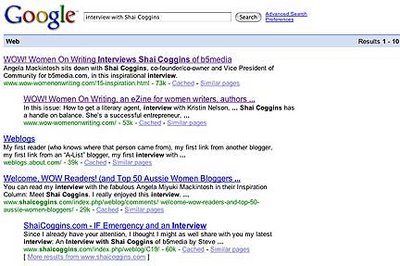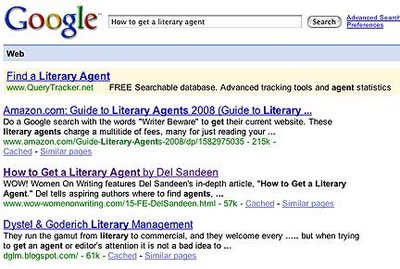SEO Sundays: How to Write Key Words
 Keywords for Webmasters AND Freelance Writers
Keywords for Webmasters AND Freelance WritersI admit I’ve been a little lax on “SEO Sundays,” but I’m back in the saddle again thanks to a little prodding. Ouch!
Today I’m going to talk about keywords, both in your meta tags, and in the articles you write. So, don’t skip out yet! This is something freelance writers should know about, not only webmasters.
As a freelancer I’m sure you’ve seen job postings that read something like, “We need a freelance writer to produce 5-10 keyword articles per week.”
In fact, if you’re a freelancer writing for an online publication, this has become the industry norm. So let’s start at the beginning.
The Gist
Not too long ago, there was a high demand for SEO copywriters. These wizards optimized your web pages by miraculously picking out a few keywords that boosted your ranking on search engines.
I’ve even had a team of these wizards approach me about WOW! saying that they’d optimize my website by creating a custom tailored set of 20 key words per year...for the small sum of a couple grand. Oh gee, thanks...but no thanks. Even when I was green that just didn’t make sense to me. I told them, “I doubt you’ll know my site better than me.” That was less than a year ago, and things have already changed.
Meta Tags aren’t all what they used to be
Search engines are no longer treating keywords as significant in your metadata. They tend to ignore the meta tag’s keywords and look to the actual page content. This is why it’s important to plan out your content before you write it and develop a set of keywords.
It used to be that you could plop 20 keywords, or 1,000 characters into your metatags and that was it. But when you think about it, this really doesn’t make much sense. If it were that easy, don’t you think people would just write anything on the page, not really caring what they wrote, and then put the real thought into their tags and not the content? Well, that’s what happened, and search engines had to be smarter. Granted, I still faithfully make a set of metatags for each and every new page/article on our website... just in case. So, let’s go over a few pointers—I wouldn’t want you to dismiss them all together because that wouldn’t be good advice. Things such as the “title” section of your metatags have more weight than any other part, so indeed, they’re necessary.
Tips for Building your Metatags
These are some basic guidelines when building metatags for your static website. Meaning, if you have a blog, you don’t really need this part, you’ll most likely have to concentrate on your content, and that’s coming up.
What metatags look like:

They all fall within the beginning head tag and head enclosure.
Note: There’s also a “robots” description that I didn’t add because for the most part, robots will follow the index automatically unless you tell it not to. It was created in 1996 and is meant to provide users who cannot upload or control the robots.txt file at their websites for the purpose of keeping a website’s content out of search engines.
STEP 1: The Title Tag
You’ll see some websites that have the same title tag throughout their whole website. I was guilty of this when I first started out. I’d put the same thing into each page of our website: WOW! Women On Writing is an Ezine that promotes the communication between women writers, authors, editors, agents, publishers and readers.
Yikes! For one thing, I quickly discovered that was way too long (too many words), and not descriptive enough for each page.
Length:
Standard practice says that the title tag of a page should describe the article in no longer than 65 characters, or 6-8 words.
Keyword or Phrase:
Put the keyword of the article or phrase into your title tag. Use your keyword once.
Examine your article:
Think of it this way: if you were doing a search on Google for a specific subject, such as, “how to get a literary agent,” wouldn’t you just type that in and see what comes up? It’s common sense.
Take a look at your article or the content of the page.
• Who are you trying to reach?
• What phrase might they type in?
• What subject is your article trying to relay?
• Get to the meat of it.
Whatever you do, make sure that phrase or keyword is actually in the article.
Tips:
Remember that the title is the most important part of the metatag. This is what you see when you do a search. It’s the part that’s underlined and highlighted in bold (if that’s the term you searched for). All search engines bold your keywords.
Yet, sometimes content can be so relevant on a static website that it shows up immediately. When I typed in: “Interview with Shai Coggins” (Note: From this month’s inspiration column) you can see we took the top two spots. Even before Shai’s website or b5media’s website.

(Note: see where it says in the upper right hand bar: Results 1-10 of about 16,000)
STEP 2: The Description
After you see the title on a search engine, right beneath it comes the description. It’s the blurb of what the article is about and how you’ll most likely decide whether or not to read that article.
Be honest:
That’s what I’ve found to work. Give a blurb of what’s included in the article (only the key points, or keywords) and describe it in no more than two sentences. You’re all writers, get to the meat of it!
STEP 3: The Keywords
Like I mentioned before, these tags aren’t cruised much by search engines anymore because they’ve been diluted. Most of the time search engines will crawl content before keywords – but there still is a necessary place for them.
Length:
Limit your keywords to no longer than 1,000 characters. Some meta tag generators use 20 key words or so, but it depends on your keywords and phrases.
Commas?
There has been some debate about whether to use commas in between your keywords. I prefer to use them, but others do not. This is because eliminating commas may increase your odds of search engines extracting different phrases from your keywords.
For instance, if your tag is "literary agents nonfiction book proposal" you might get ranked for "literary book proposal" but if the tag reads "literary agents, nonfiction book proposal," you'd have less of a chance to get ranked for "literary book proposal" because the comma separates the words.
That’s up to you. I prefer to use commas and phrases for my keywords.
Angela’s Secret Tip:
Here’s a personal tip I use for extracting keywords—and this can be used in your freelance writing for internet publications:
• Open MS Word
• Read your article and examine the key point you’re trying to get across
• Go to the “Edit” menu at the top and click on “Find”
• In the box that says “Find what” type in your keyword
• Check the box that says “Highlight all items found in” (and the dropdown box only has one choice: “Main Document”)
• Click the “Find All” button
This will immediately show you how many times that keyword is used in your article. It not only highlights the word in your article, it gives you a count right there in the box!
Take out a notepad and write that word down with the number of times it was used.
For instance: if I used the “find” tool right now to search the word “keyword” it comes out to: 34
That’s quite a hefty sum for one article!
So, examine your words and phrases, pick out the most relevant, do an MS Word Find, and tally your content. I know this is time consuming, but if you’re going to be getting paid top-dollar for your freelance writing (or if you want to), or own your own website, then these are important things to consider. Attention to detail will only help you in the long run.
Freelancers: Content is Queen
If you just scanned and cruised in because of the bold captions, do yourself a favor and read the tip up above. That applies to you!
Not a Copywriter? So what!
Truth is, keyword articles pay well. Why not learn how to roll with the times and get paid for your writing. By incorporating a few extra steps, you can make a lot more as a freelance writer.
You’ve all seen the job boards and listings for “keyword articles” – well, it’s not much different than writing a regular article. You just have to inform yourself, and soon you can be an expert.
If you’re a fiction writer:
Throw out what you know about fiction for your freelancing gigs. Throw out what you’ve learned about the dreaded “echoes” in your work, and make those echoes count. They are an important part of what will bring you the green.
As fiction writers we know it’s not good to repeat words, phrases, or even hint at the same words. Those echoes always meant that we were sloppy writers and didn’t have the capability to be descriptive. The opposite applies when you’re writing for the web. The more you can incorporate your keyword in a unique fashion so that the reader doesn’t realize it’s happening, the better.
As a fiction writer myself, I know this is one of the toughest things to do! But, think of it this way: you’re allowed to break the rules, so take advantage.
Keep your audience in mind:
When writing keyword articles, the most important thing to keep in mind is that the articles must be interesting to the target reader. Your articles should be filled with relevant content so that the reader won’t quickly move onto the next website. Give them valuable information, just like you always would.
As well as Search Engines & your Client:
Determine what your employer is trying to relate, then think of copy that will help enhance their traffic. Put yourself in their position. If you were someone searching for her particular product, or looking for some information on a specific subject, what would you search for? What keywords would you type into a search engine?
Writing it Out!
Remember not to overload your article with too many keywords. When writing your article, choose one main and two secondary keywords.
Here are a few tips to follow:
• As I mentioned earlier, make sure you include your primary keywords and phrases in your title.
• Repeat your main keyword in the first sentence of your article.
• Include your keyword as much as you can in the first 150 words of your article, as long as it’s readable and not ridiculous!
• Spread your secondary keywords throughout the rest of your copy.
• If you are writing a long article, make sure that you include your main keyword or phrase every 150 words or so at least twice.
• Include your keyword or phrase in your conclusion paragraph.
Remember your good writing ethics:
Write what sounds good and be creative when incorporating those words. Think of it as a challenge. Test yourself to see how creative you can be within a limited structure. By viewing it this way, it can be fun!
Summing it up:
Writing a keyword article is just like writing any other article. The only difference is that you’re challenging yourself to include certain words. Think of it like a prompt-based contest. You’re given a certain topic to write about and you must incorporate those words and ideas into your story. And I know all you ladies have the capability to do that, so why not try your hand at keyword articles. You may develop a unique ability to become an expert at something you’ve never thought of. Add that to your bio! And some green to your pocket.
----------
Find out more “tips & tricks” when you subscribe to Premium-Green Markets: The Women’s Freelance Guide to Writing and Markets. First issue coming up this week!
Labels: creating meta tags, freelance writing for the web, MS Word find, SEO Sundays, writing keyword articles













8 Comments:
WOW! Angela, you are an SEO diva extraordinaire! Great tips!
Now, if I can only wrap my technotard mind around the fact that I really CAN do this... Then I won't be so freaked out about all those spiders crawling around on the web getting into my stuff.
I guess it's all about the keywords. Think: Radiant Pig. ;-)
This is yet another great techie post, de-mystified! Thanks, Angela. I'm with Annette on this...a technotard. But I enjoy reading your posts on SEO angles and information, in a way that I can understand what you're saying.
Thanks!
Great entry! It must have taken appreciable length of time to finish it up! In fine it is excellent both in terms of information, analysis and its structure.
Sid's Blog
I couldn't agree more.
It's a welcome development that search spiders now focus on content to index articles and stories.
I look forward to the day (perhaps soon) when, through artificial intellingence, they are able to give higher priority to articles and stories that are well written too.
Hi guys,
Thanks for your comments! And to Rob, what an interesting idea. I think if they gave higher priority to well written articles and stories they'd have to have a team of I.A. Spider Judges to determine that factor. ;-) But then again, that might be a scary thing too.
In a way they already do give higher priority to 'interesting' articles through social bookmarking and tagging. But that doesn't mean the article is necessarily well written. It just means people enjoy that bit of news etc.
I guess we'll just have to see what the next big change will be. Things move so fast it's hard to guess... but that's what's exciting about it.
It's great to see some new faces and comments! Thanks for taking the time to say hello.
Hugs,
Angela
Right place for anchor text..that obviously in the first 150 of the seo content...unique article content and well written.
Tnx
Excellent article, Angela! Thank you for the useful tips!
One of the best article I read in a long time. Had already sent it to my content writer...
Just one thing, that was mentioned on the article, but still worth mention it again -
Since we write for people, not for search engines, but most people use search engines to find information, our title and description tags should appeal to the reader. Don't just use keywords, make your title and description as attractive as you can.
Post a Comment
Links to this post:
Create a Link
<< Home